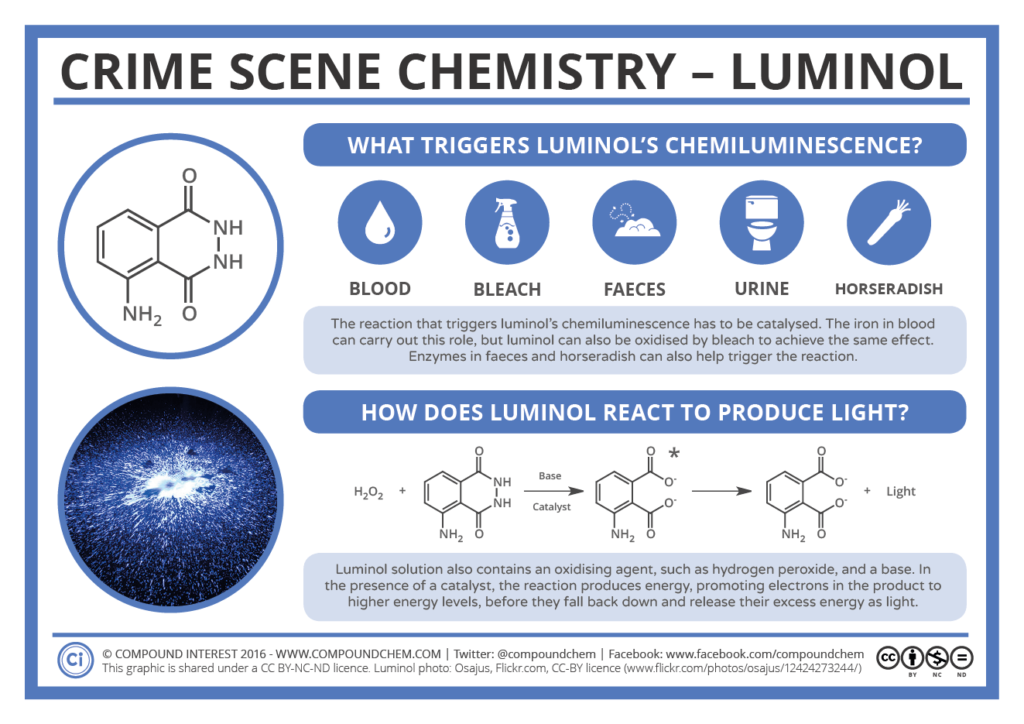In the shadowy world of crime scene investigation, one of the most fascinating tools used by forensic experts is luminol. This chemical compound has the remarkable ability to reveal traces of blood that are invisible to the naked eye, even after attempts to clean or remove them. Luminol has been instrumental in solving numerous criminal cases, often providing that crucial piece of evidence needed to bring perpetrators to justice.

What is Luminol?
Luminol is a chemical compound (C8H7N3O2) that exhibits chemiluminescence, meaning it emits light when it undergoes a chemical reaction. In forensic science, luminol is primarily used to detect blood at crime scenes. When applied to an area, luminol reacts with the iron in hemoglobin—a protein found in red blood cells—causing a blue glow that can be seen in the dark. This luminescence is temporary, lasting about 30 seconds to a minute, but can be photographed to preserve the evidence.
The Science Behind Luminol
The chemiluminescence of luminol occurs when it is sprayed onto a surface and comes into contact with an oxidizing agent. In the presence of blood, the iron in hemoglobin acts as a catalyst, speeding up the reaction. The luminol molecules are excited during the reaction, and as they return to their normal state, they release energy in the form of light. This glowing effect can reveal even the smallest traces of blood, including those that have been diluted or washed away.
Forensic Usage of Luminol
Luminol is used in various investigative scenarios, including:
- Crime Scene Investigation: When investigators suspect that blood evidence has been cleaned up or hidden, they use luminol to detect traces on floors, walls, or objects.
- Cold Cases: In old cases where blood evidence was not initially detected, luminol can be applied to potentially reveal overlooked clues.
- Linking Evidence: Luminol can help connect different pieces of evidence by revealing blood trails or patterns that suggest movement or interaction between a victim and a suspect.
- Hidden Bloodstains: Luminol is particularly useful in detecting bloodstains that have been washed away, scrubbed, or cleaned with chemicals, as it can still react with microscopic traces.
Notable Cases Where Luminol Played a Crucial Role
1. The Martha Moxley Murder Case (1975)
Martha Moxley, a 15-year-old girl from Greenwich, Connecticut, was found bludgeoned to death with a golf club in 1975. The case went cold for many years due to a lack of evidence. However, in the 1990s, investigators reopened the case and used luminol to examine the crime scene, revealing blood traces that had been overlooked. This discovery helped build a case against Michael Skakel, who was eventually convicted of the murder in 2002, nearly 27 years after the crime was committed.
2. The JonBenét Ramsey Case (1996)
The murder of 6-year-old JonBenét Ramsey in Boulder, Colorado, remains one of the most infamous unsolved cases in the United States. In this case, luminol was used extensively to examine the crime scene, particularly in the basement where her body was found. While luminol revealed the presence of blood and other biological material, the case remains unsolved, with numerous theories and suspects, but no conclusive evidence to bring a conviction.
3. The Paul Bernardo and Karla Homolka Murders (1990s)
Paul Bernardo and Karla Homolka, a Canadian couple, were responsible for the brutal rape and murder of several young women, including Karla’s own sister, Tammy. During the investigation, luminol was used to reveal blood traces in their home, despite their efforts to clean up the crime scenes. The evidence uncovered by luminol played a significant role in convicting Bernardo, while Homolka received a controversial plea deal in exchange for her testimony against Bernardo.
4. The Louise Woodward Case (1997)
In this highly publicized case, British au pair Louise Woodward was accused of murdering 8-month-old Matthew Eappen in Massachusetts. Luminol was used in the investigation to detect blood traces in the home where Woodward worked. While the luminol tests did not directly lead to a conviction, they contributed to the overall evidence considered during the trial, which resulted in Woodward’s conviction for involuntary manslaughter.
5. The Richard Crafts “Woodchipper” Murder Case (1986)
One of the first murder convictions in the absence of a body in the United States involved Richard Crafts, who was convicted of murdering his wife, Helle Crafts, in Connecticut. Investigators suspected that Crafts had disposed of his wife’s body using a woodchipper. Luminol was used to detect traces of blood in the home and on the equipment Crafts used. The luminol findings, along with other forensic evidence, helped convict Crafts of murder, even without the discovery of a full body.
Challenges and Limitations
While luminol is a powerful forensic tool, it has its limitations. One major challenge is that luminol can react with substances other than blood, such as certain cleaning products, rust, and even some types of vegetable matter, leading to false positives. Additionally, the luminol reaction can dilute or destroy blood evidence, making it difficult to conduct further tests, such as DNA analysis. Therefore, luminol is often used as a preliminary screening tool, with more detailed tests conducted on the samples it reveals.
Conclusion
Luminol has become an indispensable tool in forensic science, allowing investigators to uncover hidden blood evidence that can be critical in solving crimes. Its ability to reveal what is invisible to the naked eye has helped crack cold cases, convict murderers, and bring justice to victims and their families. However, like all forensic tools, it must be used carefully and in conjunction with other methods to ensure accurate and reliable results.
Latest Update: Recent advancements in forensic science are focusing on developing new luminol formulations that reduce the risk of false positives and enhance the visibility of blood traces in challenging environments. Additionally, researchers are exploring the use of alternative light sources and imaging technologies to complement luminol’s capabilities, potentially leading to even more effective crime scene investigations.
